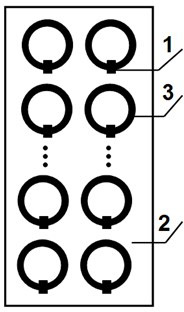Superlens based on artificial electromagnetic structure in nuclear magnetic resonance imaging
A nuclear magnetic resonance imaging and artificial electromagnetic technology, which is used in medical science, sensors, diagnostic recording/measurement, etc., can solve the limitation of the working frequency and working bandwidth of the electromagnetic superlens, the difficulty of designing the electromagnetic superlens, and the difficulty of making hardware equipment such as detection coils. and other problems, to achieve the effect of structural scalability, high signal-to-noise ratio, and high spatial resolution
- Summary
- Abstract
- Description
- Claims
- Application Information
AI Technical Summary
Problems solved by technology
Method used
Image
Examples
Embodiment Construction
[0018] The present invention will be further described below in conjunction with accompanying drawing.
[0019] The invention designs a curved annular artificial electromagnetic hyperlens based on an LC loop resonance unit, and utilizes its novel electromagnetic properties to enhance signal excitation response and detection of surface coils in nuclear magnetic resonance imaging. Under the same equipment conditions, the electromagnetic metalens can realize the focusing of the excitation coil and the super-resolution imaging of the detection coil in the MRI system, so it can realize depth and fixed-point (limited area size) detection, and effectively improve the signal-to-noise ratio.
[0020] Such as image 3 As shown, a metalens based on artificial electromagnetic structure in nuclear magnetic resonance imaging includes an inner fixed ring, an outer fixed ring and a plurality of resonance units 4, and the resonance unit 4 is vertically arranged between the inner fixed ring and...
PUM
 Login to View More
Login to View More Abstract
Description
Claims
Application Information
 Login to View More
Login to View More - R&D
- Intellectual Property
- Life Sciences
- Materials
- Tech Scout
- Unparalleled Data Quality
- Higher Quality Content
- 60% Fewer Hallucinations
Browse by: Latest US Patents, China's latest patents, Technical Efficacy Thesaurus, Application Domain, Technology Topic, Popular Technical Reports.
© 2025 PatSnap. All rights reserved.Legal|Privacy policy|Modern Slavery Act Transparency Statement|Sitemap|About US| Contact US: help@patsnap.com



